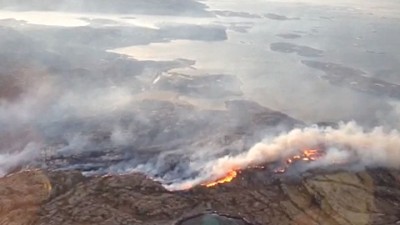A fire which razed an entire peninsula in Flatanger, Nord-Trøndelag on Tuesday flared up again in the evening, breaking through containment lines and creating a two kilometre fire front. Crews had spent the afternoon soaking a kilometre-wide fire break on the narrow section of the headland, but failed to contain the blaze.

“It’s so serious that now all we can do is let areas burn,” police incident controller Morten Hegdal told Norwegian Broadcasting (NRK). “Also we must concentrate on saving the buildings that are in danger, and stopping the fire from spreading out from the peninsula.”
Crews had entered a crucial phase of the fight to control the blaze on Tuesday afternoon, concentrating resources on a containment line across a narrow part of the peninsula. The wind was then working in their favour, but later pushed the fire into new terrain with a lot of combustible material. Hegdal said strong headwinds are fanning the fire forward at a rate of many metres each minute.
Firefighters worked into the evening to stop the fire from jumping a road and threatening two farms. Jan Birger Jacobsen, Nord-Trøndelag police chief of staff said the fire was not under control, but the flames were moving steadily eastwards in the direction of fire breaks. “We believe the fire break we’ve built will not be broken,” he said.
On Tuesday night police revised the damage toll, estimating 90 buildings had been destroyed since the fire broke out on Monday night. It’s believed to have been sparked by strong winds in power lines, sparking unseasonably dry undergrowth. Criminal investigators were due to begin examining the ignition point early on Wednesday to rule out any foul play. The fire spread quickly northwards from Uran, all but leveling the villages of Hårstad, Småværet and Hasvåg. All 32 residents were evacuated, as the fire threatened homes, farms, industry and marinas in the area.
Historic buildings threatened
Lillian Mårvik Engbakken and her family are the only permanent residents of Småværet. She was evacuated on Monday from the heritage waterfront trading post that has been in her family for 100 years. Engbakken runs a museum and holiday rental reception from the building.
“I hope and pray to God that he doesn’t let the fire destroy everything,” she told NRK. She had not yet heard if her home had been spared, but feared for the worst. “I’m thinking of how I made a little museum there with Småværet history. Old things, pictures and antiques which have gone down through my family are now lost.” Engbakken said she’s insured, but the history is irreplaceable.
Birgit Fossvik lives in Hasvåg, an old fishing village and popular summer destination dotted with cabins and homes. She told NRK on Tuesday she was prepared for her home and family tourism business to be gone. “I feel like my soul has gone,” she said. “There are a few of us who’ve now seen our life’s work disappear.”
Like a nightmare
The Jacobsen family also had to flee on Monday night. Ludvik Elnan Jacobsen, aged 13, told NRK his parents had gone to help fight the fires when the flames suddenly spread over the mountains. “As we were driving from the house we saw the sky behind the mountain was completely red,” he said. “We drove inland, and as we got further we saw the flames flaring up. They were everywhere. It was like a nightmare.” Ludvik said his father’s childhood farm has been destroyed, but they’re holding out hope their home was safe.
Justice and Security Minister Anders Anundsen visited Flatanger on Tuesday afternoon, and said the most important thing is to band together to help those affected by the tragedy. “This has affected many,” he said. “Many people have lost everything they own. Memories have been lost. It is a critical situation when forest and brush fires start up under these weather conditions.”
Anundsen praised the crews battling severe weather conditions to control the fires. Several water bombing helicopters remained grounded throughout Tuesday due to the strong winds and poor light. About 100 local fire fighters and 25 civil defense staff were deployed, but the danger was so great they could not enter the peninsula to save remaining homes until Tuesday afternoon. Two coast guard boats and a rescue boat also joined the fight.
Winter fires
While many parts of Norway are covered in snow, large areas of the country have had a long dry spell with little precipitation. Midt-Hedmark fire chief Nils Erik Haagenrud is part of the group coordinating the Flatanger defense. He said the rough terrain, winter winds and poor visibility were throwing up challenges. “The greatest danger is that the fire fighters end up in a position they can’t get out of, then they can risk becoming engulfed,” he said. Darkness falls early in winter, and for the crews’ safety they were pulled back during the night.
Fire danger also remained high in the southern part of Nordland, Trøndelag and Vestlandet due to strong winds and dry forests. Fire destroyed about 40 buildings in the historic mountain town of Lærdal 10 days ago. In Hyllestad in the Sogn and Fjordane area, crews have had to return 11 times to a grass and heather fire that flared up over and over. Emergency services told NRK they’d be on high alert while it remained so dry, especially over weekends.
newsinenglish.no/Emily Woodgate

